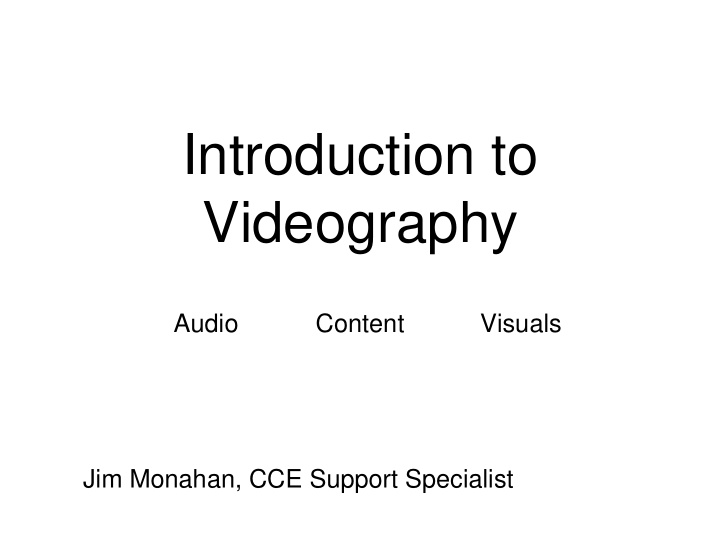



Introduction to Videography Audio Content Visuals Jim Monahan, CCE Support Specialist
AUDIO Audio is the most important component of any video. If it is difficult to hear what people are saying it doesn’t matter how good the content is no one will want to listen to it. THE KEY TO GOOD AUDIO 1. Shoot in a quiet place. 2. Get the microphone as close to your subject as you can.
BEFORE FILMING STOP AND LISTEN TO YOUR SURROUNDINGS • Wind • Running Water • Air Conditioner • Tractor • Traffic • People • Birds If you can hear these sounds the microphone can too • Windy Day Example “Don’t worry the editor can fix it later”
“You can make bad wine from good grapes but you can’t make good wine from bad grapes.” • By preparing in advance you can save yourself and your editor a lot of time. • Be willing to start over. • Rainy Day Example.
WHAT MICROPHONE SHOULD I USE? In Camera Shotgun Lavalier Smartphone/Recorder
CONNECTING THE MIC TO THE CAMERA VS. USING AN EXTERNAL RECORDER
PRO AND CONS Shotgun Mic Excellent sound quality, limited ambient noise, great choice when working • with video professionals. Difficult to set up and use well, must be very close to the subject, • often the signal needs to receive a 20db boost before going into a camera, usually requires an XLR connection. Lavalier Mic Good sound quality, inherently close to your subject, excellent at limiting • ambient noise. Potential for rustling sound on clothing, when using a wireless system • beware of interference, may need to receive a 20db boost before going into the camera. Can plug directly into a smartphone.
CONTENT NARRATIVE STRUCTURE ACT 2 ACT 1 ACT 3 quest for problem resolution solution
Testing Cold Hardiness Video Introduction Quest for Solution Challenge Resolution Rising Action Solution
QUICK TIPS AND SUGGESTIONS • Think about your audience. • Strike a conversational tone. • Practice what you are going to say. • Record multiple takes until you get it right. • Talk slowly and clearly. • May be helpful to use questions instead of a script.
VISUALS “Wow, that looks really great you must have a really nice camera” You do not need an expensive camera. If you light and compose an image well it will look nice. $8,000 Camera $250 Camera
Take advantage of natural light and scenes with a large depth of field Cloudy Day - Nice Diffused Lighting Window Light - Modest Contrast
SOMETIMES YOU DON’T HAVE DEPTH THINK ABOUT HOW YOU WILL EDIT WHILE YOU SHOOT Medium Close Up
WHAT TO AVOID Backlighting Windows in the shot Direct Sunlight Hats and Sunglasses
FRAMING YOUR SUBJECT • Use the rule of thirds. • Look just off camera, not into the camera. • Have them look into the other two thirds. • Keep eyeline level with camera.
Take Advantage of Angles and Lines
WHAT CAMERA SHOULD I USE? BEGINNER Smartphone - easy to use, good video quality, will automatically set exposure and focus, easy to transfer video off to editor, requires external recorder or wired mic Camcorder - easy to use, okay video quality, will automatically set exposure and focus, can be more difficult to transfer video files, does not need an external recorder INTERMEDIATE DSLR/Mirrorless - harder to use, excellent video quality, great option for those already familiar with the basics of photography.
Recommend
More recommend